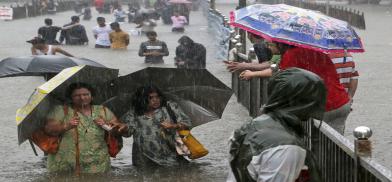Climate change: South Asia in danger of extreme events
The implications are straightforward: With rising levels of carbon dioxide in the future, there will be stronger rains with potentially destructive outcomes in the South Asian region, writes N. Chandra Mohan for South Asia Monitor

The southwest monsoon has made its annual tryst with the Indian subcontinent and South Asia since early June. During this season – June to September – normal to above normal rainfall is likely over the region. Normal means precipitation that is 96 to 104 percent of the long period average of 887.5 millimeters.
Above normal rainfall is likely along the Himalayan foothills, central and western India whereas normal rain is expected along most parts of India, including the southern peninsula, north Myanmar, Sri Lanka, Bhutan and Pakistan.
The monsoon will be below normal in Afghanistan and adjoining areas of Pakistan and South Myanmar according to the South Asian Climate Outlook Forum.
Monsoon and South Asia
The southwest monsoon is crucial to South Asia that is home to nearly one-fourth of the world population, a significant proportion of which depends on agriculture. In India, for instance, more than three-fifths of its farmers cultivate crops without irrigation. It is this segment that seeks deliverance from the dark clouds that cross Kerala’s coast every June, sweep over the peninsula and shower the rest of the country including South Asia with rain till September.
Farmers reap record harvests with bountiful rains but when they are particularly heavy it often causes flooding and crop disruption. This seasonal precipitation thus plays a large role in the livelihoods of 1.4 billion people.
The southwest monsoon, however, has been wayward and unpredictable due to climate change. Predicting its spatial and temporal spread has been a daunting challenge even with sophisticated weather models. Some years ago, scientists from the Bengaluru-based Centre for Mathematical Modeling and Computer Simulation observed decreasing trends in the quantum of both pre and post-monsoon rainfall and the number of rainy days – which clearly imply a shorter monsoon.
While the number of rainy days is declining, the incidence of heavy and very heavy rainfall events – typically more than 100 mm/day and 150 mm/day respectively – have been observed to increase over time.
Extreme weather patterns
With rising global temperatures, such extreme weather events are increasingly associated with the behavior of the monsoon. New research recently published in Science Advances indicates that the South Asian monsoon will not only be wetter but will be more dangerous for the region. Using data for the past million years, it finds that increases in monsoon rainfall were associated with increases in atmospheric carbon dioxide levels and the import of moisture from the southern hemisphere. The implications are straightforward: With rising levels of carbon dioxide in the future, there will be stronger rains with potentially destructive outcomes in the region.
This data for a million years was retrieved by a research team aboard a converted oil-drilling ship JOIDES Resolution that recovered sediment core samples from the Bay of Bengal, a trip that began in November 2014. The rainwater produced by the monsoons eventually drains off the Indian subcontinent into the Bay of Bengal. The runoff from the Mahanadi and the Ganges-Brahmaputra-Meghna is in fact the largest drainage basin in South Asia. The core samples provide a record of rainfall over a million years as the runoff from the monsoon creates a layer of fresh water over the denser saline water below. Micro-organisms like plankton that live at the surface die and sink to the bottom.
The research team analyzed the fossil shells of these micro-organisms to determine the salinity of water levels they lived in, indicating changing rainfall amounts. The
researchers used other data as well like the river runoff into the Bay of Bengal that
brought with it sediment which provided another indicator of rain intensity. Plant
matter washed into the Bay also provided valuable clues that complement the insights from the fossil shells. Those core samples preserve a historical record of monsoon activity.
Dangerous implications
Wetter rainfall and low salinity were observed after periods of higher concentrations of carbon dioxide and lower levels of global ice volume and moisture-bearing winds.
According to Steven Clemens, professor of geological sciences (research) at Brown
University and lead author of the study: “We show that over the last 900,000 years,
higher CO2 (carbon dioxide) levels along with associated changes in ice volume and
moisture transport was associated with more intense monsoon rainfall” adding “that
tells us that CO2 levels and associated warming were major players in monsoon intensity in the past, which supports what the models predict about future monsoons — that rainfall will intensify with rising CO2 and warming global temperature,” according to a press release issued by Brown University.
The upshot is that regions in South Asia that get a lot more rain now are going to get
more rain in the future. This presents a clear and present danger of extreme events
despite overall indications of normal to above-normal rainfall in the region. The
dangerous implications of these trends can be minimized by seriously addressing climate change.
(The writer is an economics and business commentator based in New Delhi. His views are personal. He may be contacted at nchandramohan@rediffmail.com)










Post a Comment